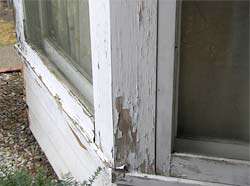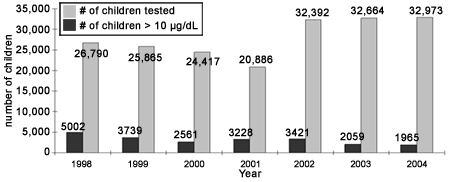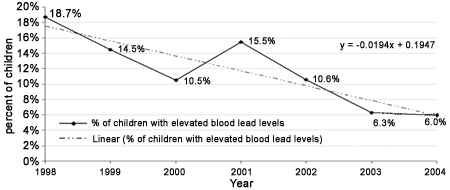Detroit River-Western Lake Erie Basin Indicator Project
Lead Poisoning in Detroit, Michigan
Background
Lead is highly toxic metal that is soft, malleable and resistant to corrosion. Despite lead's toxic characteristics, it has been used for centuries in paint, gasoline, ceramics, acid-lead batteries, and other products (Lewis 1985). The use of lead in the past and its persistence in the environment create a problem that it is still considered a major public heath concern. The National Health and Nutrition Examination Survey conducted by the Centers for Disease Control and Prevention's (CDC) National Center for Health Statistics reported that 2.2% of children younger than five (434,000 children nationwide) had elevated blood lead levels of ten micrograms per deciliter or higher.
In the City of Detroit, 6% of all children six years of age and younger tested in 2004 were identified to have lead poisoning (Detroit Department of Health and Wellness Promotion 2005a). In response to this, the City of Detroit and the State of Michigan have committed to the goal of reducing the incidence rate of new lead poisoned children (age 6 and under) to 3.2% or less by 2010. Exposure to lead has serious neurological and behavioral effects on children. According to the American Academy of Pediatrics (2005), the best studied effects of lead poisoning are cognitive impairments measured by IQ tests, but other aspects of brain or nerve function, especially behavior, may also be affected. This organization also reports that students with elevated lead levels are less attentive, hyperactive, disorganized, and less able to follow directions. Other consequences of lead poisoning are motor development delays, impaired growth and hearing dysfunction. According to the Center for Urban Studies at Wayne State University (WSU), health consequences of lead poisoning have few physical symptoms (e.g., headaches, stomachaches, sleeping or eating disorders, attention deficit disorders, and weakness or clumsiness), but significant damage to intellectual functioning is evident even at blood lead levels lower than ten micrograms per deciliter, the level of concern established by the Center for Disease Control (WSU 2003).

Figure 1. Deteriorated lead-based paint is one of the leading causes of lead poisoning in Detroit children (Photo Credit: Luciano Sanchez).
Status and Trends
Several sources of lead have contributed to contamination in the City of Detroit and lead poisoning of children. These sources include:
- lead-based paint that is deteriorated or poorly maintained (Figure 1);
- contaminated soil around former smelters located at or near residential areas that have released lead into the air during operations and been deposited on the soil;
- lead dust that has been washed into the soil from houses during rainfall;
- food and liquids stored in lead crystal or lead-glazed pottery;
- water that runs in old lead plumbing; and
- automotive emissions from leaded gasoline, in use before 1986.
Other important sources of lead contamination in the City of Detroit are former smelter sites in certain residential areas. It is at such former smelter sites where both adult and children have been exposed to long-term emissions of lead dust that settled in the soil around the industrial site, as well as outside its boundaries. Sixteen potentially harmful former lead smelters, foundries and alloy makers where identified in Detroit (Lam and Wendlandbowyer 2003a and b). Many of these smelter sites have either been abandoned or sold, and are currently performing different operations, which makes tracking responsible parties difficult. Testing has been done in some of them showing high levels of contamination, prompting further testing and analysis for lead and other heavy metals by the U.S. Environmental Protection Agency and the Michigan Department of Environmental Quality (e.g., former Master Metals, Inc., located at 4700 E. Nevada St. in the Krainzwood Neighborhood).
Although exposure to lead from ceramic products and the use of leaded gasoline in the past are not considered major sources of lead poisoning in Detroit, they are factors that must be considered. Lead was added to gasoline as a fuel additive to improve engine performance and octane ratings in the 1920s. It was phased out by government order, for public health reasons, starting in 1975 and concluding in 1986, resulting in a direct correlation with drops in elevated blood lead levels nationwide (Kovarik 2003).
Water that runs through old pipes that contain lead is considered another potential source of lead in homes. However, this should be considered the least harmful source of lead poisoning for Detroit children. Plumbing systems that may contribute lead to the household water supply have been tested since 1992. In 2002 testing showed that only two of the 51 homes tested had lead levels over the action level (Detroit Water and Sewerage Department 2004). The action level is specified by the U.S. Environmental Protection Agency as 0.015 milligrams per liter (U.S. Environmental Protection Agency 2005).
An issue of concern in southwest Detroit is the use of bean pots among residents of this community because some dishes and clay cookware contain high levels of lead in their glaze or decoration. Their use provides a direct and dangerous source of lead poisoning.
Given the various sources of lead which contribute greatly to the number of children with lead poisoning, substantial efforts are being made by health, government, non-profit, and community development organizations to increase screening and testing in the City of Detroit. For instance, the Center for Urban Studies at Wayne State University not only tracks the extent of lead poisoning in Detroit, it also evaluates effectiveness of existing prevention programs, targets new prevention activities, and evaluates programs and policies.
In conjunction with universal screening, which was approved by the CDC in 2000 and implemented in 2001, there has also been a shift towards targeted screening. In Detroit, to improve surveillance and targeted intervention programs, the Department of Health and Wellness Promotion has identified "at risk" neighborhoods within the City of Detroit. These communities, according to their 2005 Surveillance Report, are evaluated every year to identify specific areas at high risk. Results from these analyses identified six communities that had a 23% higher rate of lead poisoning among children than the rest of the City; furthermore, these communities accounted for 30% of all cases of lead poisoning in 2004 (Detroit Department of Health and Wellness Promotion 2005b). The neighborhoods identified as high risk target areas are Belle Isle, Chene, Kettering-Butzel, Rosa Parks, St. Jean, and Tireman. An interesting fact to point out is that some of those former smelter locations, mentioned above, are located in these targeted communities. Federal-Mogul Corporation was located in St. Jean. Aetna Smelting & Refining Company and Federal Alloys Corporation were located in Kettering-Butzel. Federated Metals Division of ASARCO was located in Chene and City Metals Refining Company was located in Tireman.

Figure 2. Extent of lead poisoning in the City of Detroit, 1998-2004 (total number of tested children with blood lead levels of 10µg/dL or above and number of children tested for lead poisoning; data from Wayne State University's Center for Urban Studies.
There has been a major effort to measure the extent of lead poisoning in Detroit children since 1998 and more children have been tested since universal testing began in 2001. Based on the available data, the number and percent of children with blood lead levels of ten micrograms per deciliter or more have decreased by at least 60% from 1998 to 2004 (Figure 2 and Figure 3).

Figure 3. Linear decline on the percentage of children with elevated blood lead levels from 1998 to 2004. Linear correlation was used to statistically elucidate the rate of decrease.
Management Next Steps
Proximity to residential areas should be taken into account when industrial sites are considered for cleanup. In fact, officials should target industrial cleanups to areas where traces of lead could explain higher rates of lead poisoning.
According to the Center for Urban Studies at Wayne State University it is also important to focus on primary prevention, which involves abatement (i.e., measures designed to permanently eliminate lead-based paint or lead paint hazards). Abatement includes:
- removal of lead-based paint and dust lead hazards, permanent enclosure or encapsulation of lead-based paint, replacement of components or fixtures painted with lead-based paint, and removal or permanent covering of soil lead hazards; and
- all preparation, cleanup, disposal, and post abatement clearance testing activities associated with such measures.
To help reach this goal, two important reports were published in 2005 by the Detroit Department of Health and Wellness Promotion's Childhood Lead Poisoning Prevention and Control Program in collaboration with 70 partners comprised of community based and governmental agencies: a 2004 Annual Childhood Lead Poisoning Report (Detroit Department of Health and Wellness Promotion 2004), and a Strategic Lead Elimination Work Plan for the City of Detroit (Detroit Department of Heath and Wellness Promotion 2005a). A coordinating body has now been established to assure accountability to the public and to monitor the implementation and evaluation of the Strategic Lead Elimination Work Plan.
The Strategic Lead Elimination Work Plan outlines activities that must be executed in order to accomplish the lead poisoning reduction goal in Detroit by 2010; it also establishes time frames and identifies responsible or involved parties. The progress of this Strategic Lead Elimination Work Plan will depend on the implementation and close evaluation of each objective below:
- reduce childhood lead poisoning cases (confirmed greater than, or equal to, ten micrograms per deciliter) by 1% annually through education and outreach;
- increase the number of children tested annually by 5% (baseline 35% in 2003);
- target lead testing to high risk populations living in Detroit: Medicaid enrolled children, children 0-3 years old, and ethnic groups;
- prevent lead exposure among Detroit children by increasing primary prevention activities targeted to pregnant women, newborns, and children ages 1-2 with blood lead levels of 4 to 9 µg/dL in high risk areas;
- create lead safe housing in Detroit by 2010;
- enhance legislation regarding the control on environmental lead hazards and the lead code enforcement in Detroit; and
- acquire funding and resources to adequately fund and support lead poisoning prevention, remediation, and treatment intervention.
Research/Monitoring Needs
Wayne State University's Center for Urban Studies pointed out that new research should focus on ways of prioritizing abatement and prevention, and also identifying which programs will eliminate the problem of lead poisoning more efficiently and effectively.
A concrete example relates to one of the Strategic Lead Elimination Work Plan's objectives that anticipates the creation of lead free housing by 2010. Abatement of a house can cost as much as $20,000, with an average of $10,000. Dividing the available funding by this average, Detroit can abate approximately 200 homes per year. However, this is clearly not enough given that 90% of Detroit housing stock was built before 1978. Even though this is a problem that needs to be addressed in the near future, its complexity highlights the importance of continuous interim controls or measures designed to temporarily reduce human exposure or likely exposure to lead and lead hazards (e.g., repairs, painting, temporary containment, specialized cleaning, and lead based paint maintenance activities). According to the Center for Urban Studies at Wayne State University, interim controls are currently considered a major way to address the housing problem in the City of Detroit, therefore research should be conducted not only to monitor the effects of interim controls, but also to improve and expand such measures.
Continued research is also warranted on human health effects of lead poisoning. It will take coordinated work, focused management of each factor that has an effect on lead poisoning in children, and a comprehensive approach to addressing all sources of lead in the environment to reach the goal of reducing the incidence rate of new lead poisoned children to 3.2% or less by 2010.
References
- American Academy of Pediatrics. 2005. Lead Exposure in Children: Prevention, Detection and Management. Policy Statement. Vol. 116, No. 4: 1036-1046. (December 2005).
- Center for Disease Control (CDC). 2000. Childhood Lead Poisoning Prevention Program: Children's blood lead levels in the United States (December 2005).
- Department of Health and Wellness Promotion. 2004. Childhood Lead Poisoning Prevention and Control Program. 2004 Annual Report (PDF). (December 2005).
- Detroit Department of Health and Wellness Promotion. 2005a. Childhood Lead Poisoning Prevention and Control Program. Strategic Lead Elimination Work Plan for the City of Detroit. (December 2005).
- Detroit Department of Health and Wellness Promotion. 2005b. Childhood Lead Poisoning in Detroit, Michigan: Surveillance Report 2005 Edition. Detroit, Michigan.
- Detroit Water and Sewage Department. 2004. Water Quality Report (PDF). (December 2005).
- Kovarik, W. 2003. The Ethyl War, Forbidden Fuel and Public Poison, The Ethyl War Summary: Leaded Gasoline History and Current Situation (2005).
- Lam. T. and W. Wendlandbowyer. 2003a. Potential of danger at 16 sites brings little action. Detroit Free Press. (2005).
- Lam, T. and W. Wendlandbowyer. 2003b. Old Sites Forgotten, Ignored. Detroit Free Press. (2005).
- Lewis, J. 1985. Lead Poisoning: A Historical Perspective. U.S. Environmental Protection Agency. Washington, D.C.
- U.S. Environmental Protection Agency. 2005. Drinking Water Contaminants and Maximum Contaminant Levels (2005).
- Wayne State University (WSU). 2003. Lead Poisoning Research at the Center for Urban Studies. Detroit, Michigan.(2005).
Contact Information regarding Lead Poisoning in Detroit, Michigan
Valerie Monet
Center for Urban Studies, Wayne State UniversityE-mail: V.Monet@wayne.edu
Guadalupe Cummins
Department of Biology, Wayne State UniversityE-mail: aq4983@wayne.edu